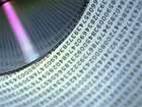
The Microholas technique works by using the whole disc as a storage medium, building five clear layers that all reflect light at different wavelengths.
Conventional discs store information pitted on the surface, allowing around a tenth as much capacity. Micro-holographic recording can be used on recordable discs and the reader can transfer at 50Mbps.
The team hopes to be able to store one terabyte on the discs by 2010 and have a reader capable of 200Mbps by the end of 2010.
"The implementation of micro-holography for digital data storage on a disk has the potential to become a major breakthrough in realising terabyte optical storage," said the team.
"The main advantage is that it takes bit-oriented storage to the third dimension. By using holographic multiplexing, tracks can be overlapped in the same volume. Very high storage densities of more than 100 bits/µm2 can be achieved in this way."
Microholas has cost around €2m and has taken three years to complete. The project involved researchers from Hungary, Germany, Italy and France.



_(22).jpg&h=140&w=231&c=1&s=0)




_(26).jpg&w=100&c=1&s=0)

 iTnews Executive Retreat - Security Leaders Edition
iTnews Executive Retreat - Security Leaders Edition











_(1).jpg&h=140&w=231&c=1&s=0)



